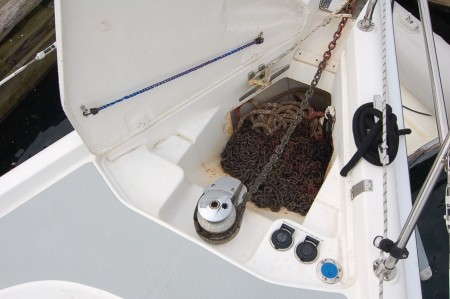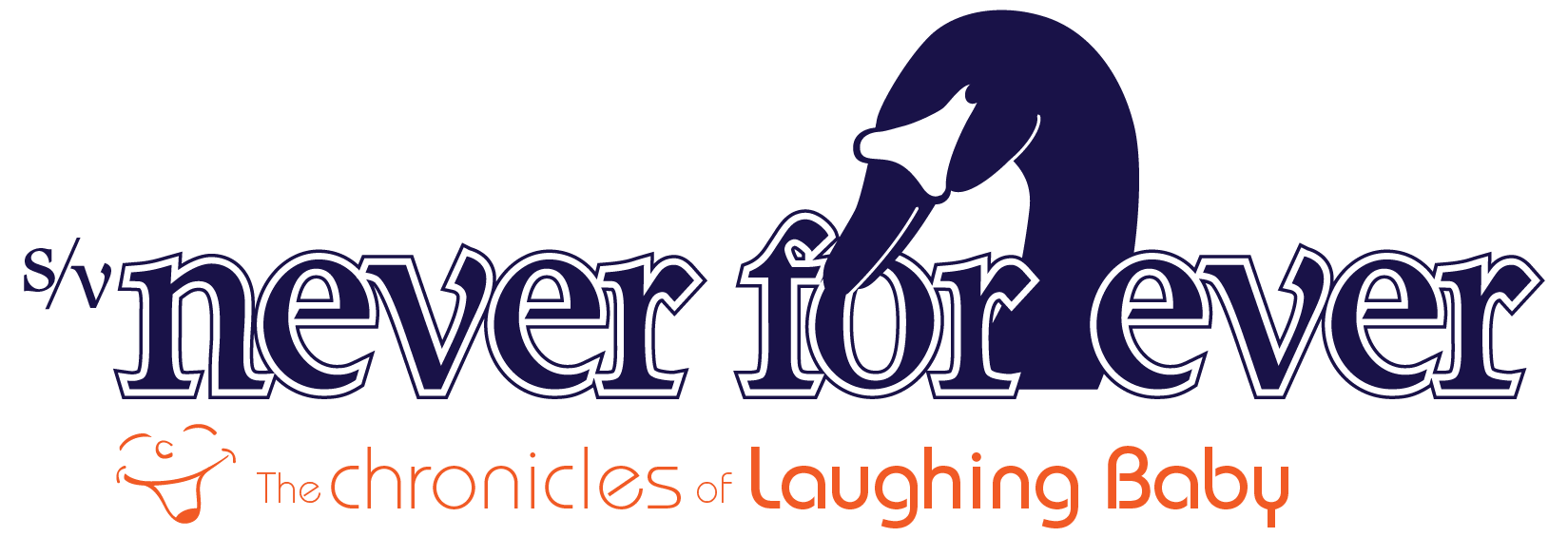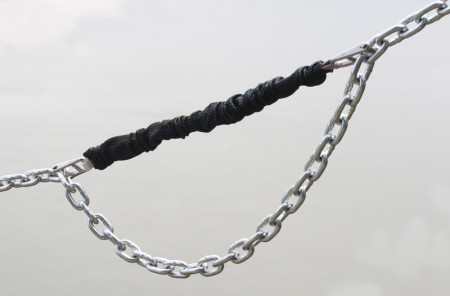Anchors away…
There are three things you shouldn’t talk about in public if you aren’t prepared for a rousing discussion: religion, politics and anchors.
Anchors
Never for Ever currently has a 33lb Lewmar claw anchor with 105′ feet of chain and 295′ of line, as well as a Lewmar electric windlass (the turny thing that lifts and lowers the anchor).

We’ve chartered a couple of boats with Rocna anchors while staying in windier anchorages and have convinced ourselves a new generation anchor is a must. A new generation anchor is loosely defined as one that:
- always positions itself correctly — if it falls upside down, it automatically turns over under natural conditions.
- turns with the wind and tide without pulling free.
- offers good holding power and will not pull out.
- will grip on to rock and coral if at all possible.
Older anchors tended to be much more specialized for different types of bottoms e.g. sand, clay, rock, etc. That doesn’t mean they are bad but that they take more skill and judgement than a n00b like me usually possesses. Or so I am telling myself because I want to buy a new anchor.
The main contenders in today’s market place seem to be the Rocna, The Manson Supreme and the Mantus but there are others like the Ultra, SARCA and Kobra.
Now we haven’t made up our minds on which to choose (although I am leaning to the Mantus based entirely unscientifically on this thread over on Cruisers Forum, but the sizing has me baffled. For example if you go to the manufacturer’s websites :
• Rocna recommends the 20kg (40lb) all the way up to the 33kg (73lb)
• Manson recommends 30lb to 40lb
• Mantus recommends 45lb to 65lb
So how do I figure out which is appropriate, and more importantly, what fits?
Anchors Online
I’ve asked around, which as I mentioned, is not the best strategy if you want a simple answer and not an argument full of digressions and anecdotal evidence about the time they were anchored during the meltemi in the winter of ’94 etc. Many old salts still default to the old standards and won’t acknowledge any advances and woe if there was ever a documented or even rumoured case of any particular brand failing in some way. It can be pretty amusing. But in the end it seems that the answer, like in all things boating, is it depends. The range of bottom types, depths, protection from winds seems to be infintie
Still my unscientific bias towards the Mantus doesn’t seem to have any detractors and a few other 38-footers out there went with the 45lb version so I am 95% sure I have made my choice. Our bow roller (see pic above) is pretty open so I don’t think there will be a fit problem. Mantus does have printable templates so I will likely print one out and check it on the roller. We do have dual rollers, so I might even keep the Lewmar there as a backup. It runs around $400, but I have yet to find a Canadian distributor for Mantus not based out of Quebec. It might have to be mail order; what the hell, it’s only 45 pounds 🙂
The System
Of course the anchor is only one part of the anchoring system. As I mentioned I have 100′ of chain which is pretty good for the area we will be sailing. The chain itself basically acts like a weight to keep the rode (all the stuff attaching the anchor to the boat) laying flat on the bottom. An anchor works by pulling it parallel to the ground and allowing the tip to dig down; the weight of the chain helps ensure the shank of the anchor does not lift. Incidentally, that is also why you usually put out so much rode (5 to 7 times the depth of the water); you don’t want the the rode pulling straight up at any time: that’s what will break the anchor’s hold on the bottom.
Watch this (admittedly biased) video to get an idea of how anchors dig in.
If you read the discussion I started here: Living aboard in the PNW in Comfort, you will see there are many advocates for an all-chain rode of 300′ or longer. But that adds weight to the bow and costs dollars, so I think I will let it pass for now. And my electric windlass will relieve me of any possibility of having to strain my back (surprisingly many cruisers don’t have electric windlasses; I think it must be a power thing).
The only other thing I will need is a snubber. In depths of 15′ or so we will only have about 100′ out so that means it will be all chain. Chain has no elasticity and so the action of wind and waves can shock load the system and apply disproportionate forces on the static chain and on the anchor with the potential of disastrous consequences — that’s the same reason why we climb with a dynamic rope. There are all sorts of fancy rubber dohickys but the simplest system is to use a chain hook attached to a length of line and to use that to take the tension off the chain.
Backups
Never for Ever also comes with a secondary anchor to use in an emergency and in situations where two anchors might be advisable (to keep the boat from swinging or pointed into the waves etc.). It’s a 16lb fortress with 10′ (I think) of chain and the rest rope. The great thing about the Fortresses are they are light, store flat and dig in well.
The whole kit is in a tidy package in one of the rear lockers.
Marking the rode
The other thing I will likely have to do is mark (or re-mark) the rode in increments. Since when anchoring, we are trying to lay out a specific length of rode it is useful to mark the chain every 10′ with paint or some other type of marker so you can count out the length as it disappears into the water.
Yup, there is a lot of math in anchoring; that’s why it’s generally Leslie’s job. For example if you decided to anchor in 15′ of water according to your depthsounder, you need to check the tide charts and see the maximum high and low tides—they can vary by 10 feet or more. The low tide show if its safe to anchor there at all and the high tide is to calculate the maximum depth. Let’s say the high tide adds another 5′ so you are actually anchoring in 20′ of water. Then you add the height of the bow roller off the water —usually another 4 feet— and the difference between you depth sounder and the water level (sometimes this is adjusted for in the depth meter and sometimes it’s not).
So you have a total of 24′ and you only want to lay out 5 times that since it’s a pretty protected anchorage. That means whoever is letting out the anchor needs to count the number of red marks going by so they can stop around the 120′ mark. It’s easier if you have the 100′ marked in yellow or some other colour. And of course I know we have 105′ of chain so when the chain runs out you know where you are. Math. Yuck.
But anyway, I am going to buy a new anchor. Yea!











